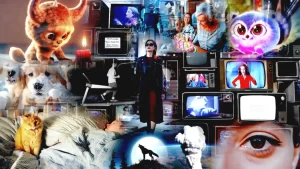
In today’s interconnected world, businesses are constantly seeking innovative ways to expand their reach and captivate audiences worldwide. One revolutionary solution that has emerged in recent years is the advent of AI dubbing tools. Leveraging the power of artificial intelligence (AI), these cutting-edge software applications are designed to automatically translate and dub videos into multiple languages, opening up a world of possibilities for businesses seeking to connect with diverse markets. In this article, we will explore the inner workings of AI dubbing tools, their benefits, limitations, and the promising future that lies ahead.
Understanding AI Dubbing Tools
What are AI dubbing tools?
AI dubbing tools are a type of software that can automatically translate and dub videos into different languages. This is done using artificial intelligence (AI) to transcribe the video, translate the transcription, and then generate a voiceover in the target language.
How do AI dubbing tools work?
At the heart of AI dubbing tools lies a combination of machine learning and natural language processing (NLP) techniques. To begin, the software transcribes the original video’s audio content into text using a sophisticated speech-to-text engine. Next, the tool utilizes a machine translation engine to convert the transcribed text into the desired language. Finally, a text-to-speech engine generates a new audio track in the target language, effectively dubbing the video.
Advantages of AI Dubbing Tools:
- Time and Cost Efficiency: Traditionally, businesses relied on human translators and voice actors to dub their videos, a process that was not only time-consuming but also financially burdensome. AI dubbing tools streamline this workflow, automating the entire process and significantly reducing costs while ensuring faster turnaround times.
- Access to a Global Audience: By transcending language barriers, AI dubbing tools empower businesses to reach a global audience. Dubbing videos in multiple languages enhances accessibility and engagement, thereby increasing the potential for higher sales and revenue generation.
- Enhanced Video Quality: Human errors in translation and voiceover work can often result in poor-quality dubbed videos. Conversely, AI dubbing tools produce more accurate and natural-sounding voiceovers, ensuring an immersive and seamless viewing experience for audiences across different languages.
Benefits of AI Dubbing Tools:
In addition to the core advantages outlined above, AI dubbing tools offer several supplementary benefits that can greatly impact businesses:
- Improving SEO Rankings: By translating videos into multiple languages, businesses can broaden their content’s accessibility, thus attracting a larger audience. Increased views and engagement contribute to improved search engine optimization (SEO) rankings, bolstering the online presence and visibility of businesses.
- Building Brand Awareness: Multilingual dubbing enables businesses to connect with diverse audiences, introducing their brand to new markets and fostering brand awareness. Expanding reach in this manner often leads to increased sales and brand recognition.
- Providing Multilingual Customer Support: AI dubbing tools can be leveraged to create customer support videos in various languages, facilitating better communication and service for international customers. This personalized experience enhances customer satisfaction and loyalty, solidifying business-client relationships.
Limitations of AI Dubbing Tools:
While AI dubbing tools present numerous advantages, it is important to recognize their current limitations:
- Accuracy: AI dubbing tools, though advanced, may not always match the precision of human translators. Contextual nuances, idiomatic expressions, and complex technical terminology can pose challenges for accurate translation and may require human intervention for optimal results.
- Naturalness of Voiceovers: Achieving the same level of naturalness as human voices can be a hurdle for AI dubbing tools. While advancements continue to be made, the subtleties of tone, emotion, and intonation found in human speech can prove difficult to replicate faithfully.
- Language Limitations: AI dubbing tools are continually expanding their language repertoire. However, certain lesser-known or rare languages may not yet be supported, presenting a constraint for businesses targeting specific niche markets.
Future of AI Dubbing Tools:
With each passing day, AI technology advances, driving the continuous evolution of dubbing tools. The future holds great promise for the field, offering exciting developments and improvements:
- Enhanced Accuracy and Naturalness: As AI technology progresses, AI dubbing tools will continue to refine their translation capabilities, ensuring greater accuracy and delivering voiceovers that sound even more natural, approaching the authenticity of human voices.
- Expansion of Language Support: Future iterations of AI dubbing tools will aim to bridge the language gap by encompassing a broader array of languages. This expansion will grant businesses access to an even wider audience, transcending linguistic boundaries.
- Increased Versatility: AI dubbing tools will evolve into more versatile solutions, offering a range of features beyond translation and dubbing. These tools may incorporate voice modulation, customization options, and adaptable voice characteristics, enabling businesses to tailor the voiceover experience to their specific needs.
Conclusion
In conclusion, AI dubbing tools have emerged as a game-changing technology, empowering businesses to unlock global reach and engagement. By harnessing the power of AI, these tools streamline the translation and dubbing process, saving time, reducing costs, and delivering high-quality multilingual content.
While limitations remain, such as accuracy and naturalness, ongoing advancements in AI technology offer a promising future, where businesses can seamlessly communicate with audiences worldwide, build brand awareness, improve SEO rankings, and provide exceptional multilingual customer support.
As we move forward, AI dubbing tools are poised to revolutionize the way videos are translated and dubbed, forever reshaping the landscape of global communication.






